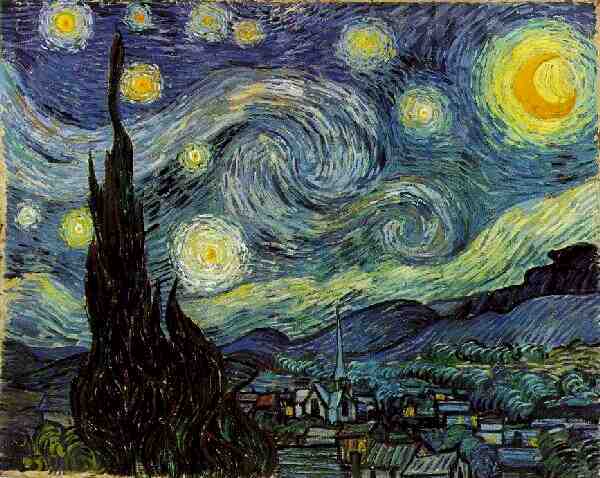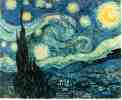| "Van Gogh said very little about the Starry Night, providing
neither a minimal inventory nor any explanation as to why he painted it
when he did. Later commentators have concentrated on its complex symbolic
imagery" (Pickvance 103). Vincent Van Gogh's most famous work, Starry
Night, has been a question mark to scholars since 1889, the year it
was painted. Art historians have speculated about the painting's origin
over the years; theories include: a rewriting of the Bible (Genesis or
Revelations), a result of his deteriorating mental state (Van Gogh was
in an asylum when he painted it), a result of Emile Zola's writings, and,
alas, a visual interpretation of Walt Whitman's poetry. It is this last
theory that I am interested in for the purposes of this site.
Van Gogh on Whitman
It is admittedly a stretch to label Vincent Van Gogh a Whitmanian painter,
but there is irrefutable evidence that Walt Whitman's poetry influenced
Van Gogh's most famous painting. But Whitman's influence is clear from
Van Gogh's mindset in late-1888 to mid-1889, when he painted Starry
Night. The fact that Van Gogh not only admired Whitman but was avidly
reading him during this time surfaces in a letter to his younger sister
Wilhelmina:
Have you read the American poems by Whitman? [his italics]
I am sure Theo has them, and I strongly advise you to read them, because
to begin with they are really fine, and the English speak about them a
good deal. He sees in the future, and even in the present, a world of healthy,
carnal love, strong and frank� of friendship� of work� under the great
starlit vault of heaven a something which after all one can only call God�
and eternity in its place above this world. At first it makes you smile,
it is all so candid and pure; but it sets you thinking for the same reason.
The "Prayer of Columbus" is very beautiful (Van Gogh 445).
This passage illustrates that, without doubt, Van Gogh was reading Whitman
around the time he painted Starry Night. This letter was written
around September or October of 1888, and Starry Night was painted
in June 1889. To further link Whitman to Van Gogh's painting, it is important
to note the letter Van Gogh wrote to Wilhelmina before the above section
on Whitman. This letter was written around 8 September 1888. "At present
I absolutely want to paint a starry sky. It often seems to me that the
night is still more richly colored than the day, having hues of the most
intense violets, blues and greens" (Van Gogh 443). To clarify, the chronology
is as follows: Van Gogh tells his sister that he wants to "paint a starry
sky," then he recommends that she read "the American poems by Whitman."
Whitman and the starry sky were both in his head before they synthesized
into Starry Night. Though he never said much about the painting,
is there a better explanation than what he says in the above letter?:
"Under the great starlit vault of heaven a something which after all one
can only call God" (Van Gogh 445).
The fact that Van Gogh entitled the painting Starry Night is
another allusion to Whitman, since Whitman's From Noon to Starry
Night was first published in France in 1888 (Schwind 4). "That Whitman
is central to Starry Night is suggested not only by the reference
of the title, but by Van Gogh's description of the work in his letters.
Starry Night, Van Gogh told his brother and [Emile] Bernard, was
his only �poetic' or imaginative subject; it is a version of the portrait
of �the poet in a starry night' that Van Gogh first mentioned to Bernard
in late 1888" (Schwind 4). Van Gogh, while thinking about a painting of
a starry sky, was reading and admiring the works of Walt Whitman.
Starry Night inspired by "Song of Myself"
Whitman's "Song of Myself," particularly section 21, is the work that
inspired Van Gogh:
I am he that walks with the tender and growing night,
I call to the earth and sea half-held by the night.
Press close bare-bosom'd night--press close magnetic nourishing
night!
Night of south winds--night of the large few stars!
Still nodding night--mad naked summer night.
Smile O voluptuous cool-breath'd earth!
Earth of the slumbering and liquid trees!
Earth of departed sunset--earth of the mountains misty-topt!
Earth of the vitreous pour of the full moon just tinged
with blue!
Earth of shine and dark mottling the tide of the river!
Earth of the limpid gray of clouds brighter and clearer
for my sake!
Far-swooping elbow'd earth--rich apple-blossom'd earth!
Smile, for your lover comes.
Prodigal, you have given me love--therefore I to you give
love!
O unspeakable passionate love (Whitman 208).
This theory focuses on the yin-yang type sexual relationship explored in
the above Whitman passage and further in Van Gogh's painting. Lewis Layman
says that: "Whitman renders his vision of a harmonious union in which
earth and sky fuse together and yet retain their distinctness" (Layman
106). Whitman gives a masculine personification in the line "I am he that
walks with the tender and growing night." Opposite this is the feminine
earth, which receives "the vitreous pour of the full moon," and brings
forth apple-blossoms. The comparison seems like a masculine night/sky power
and a feminine earth power, but Whitman jumbles the distinction with the
line, "Press close bare-bosom'd night." Layman suggests that the harmony
exists in "An interplay between two androgynous forces" (Layman 106). In
Starry Night, we see this idea visually: "The unity is similar to
Whitman's vision of the sky and the earth as distinct from each other,
yet in harmony" (Layman 106). The sexual ambiguity exists in the painting
as well. The hills' shape echoes the "bare-bosom'd night," and the large
and intruding cypress tree conjures up an image of a phallus. The crescent
moon is interesting--it is at first glance a moon, but actually resembles
a combination of a moon and sun. The moon, with a striking parallel to
the Chinese yin-yang symbol, is therefore the embodiment of harmony.
The movement of Van Gogh's paint brush also echoes Whitman's lines.
Van Gogh's sky is in a state of movement and "press[es] close" to the earth.
"The circular movement is a manifestation of a vital 'magnetic' force which
seems to draw the tree and steeple upward. The night is 'nourishing' in
the sense that it is fertile to the earth" (Layman 107).
The attraction between the earth and the sky is just as prominent in
Starry Night as in "Song of Myself." Equally pertinent to this discussion
is Van Gogh's 11 stars, each thoroughly emphasized in the painting. "He
expresses the Whitmanian sentiment that each star, like each blade of grass,
is unique yet similar to every other one" (Layman 107). No two stars are
identical in the painting, yet each is important in its relationship to
the whole. Each star has distinguishing characteristics, yet are comprised
of the same shape and colors.
The above section of "Song of Myself" is echoed in nearly every aspect
of Starry Night, and though Van Gogh himself rarely discussed this
work, Whitman's influence is hard to miss.
Conclusions
There are two other theories about Whitman's influence on Starry
Night. In her essay "Van Gogh's Starry Night and Whitman: A
Study in Source," Jean Schwind links Whitman to the painting because of
his Noon to Starry Night poems. She also examines "Prayer of Columbus,"
saying this poem and its counterpart, "Passage to India," are parallel
to Van Gogh's Starry Night and its (daytime) counterpart, Wheatfield
with Cypress. Hope Werness suggests that Starry Night shares
the cosmic consciousness of Whitman's star imagery in "When Lilacs Last
in the Dooryard Bloom'd." But the striking remnants of "Song of Myself"
in Starry Night remains the most convincing. All these theories
prove one thing: Starry Night was undeniably influenced by "the
American poems by Whitman."
"Starry Night stands out as one of the most important works of
art produced in the nineteenth century" (Brooks). The everlasting popularity
and importance of Van Gogh's painting will remain; so will the speculation
over its origin. This speculation certainly is not limited to Walt Whitman's
"Song of Myself," but the textual similarities of section 21 and Starry
Night strongly point to Whitman was an influence. And to be an influence
on one of the most important works of art produced in the nineteenth century
shows Walt Whitman impacted the visual arts world with his poetic imagery. |

